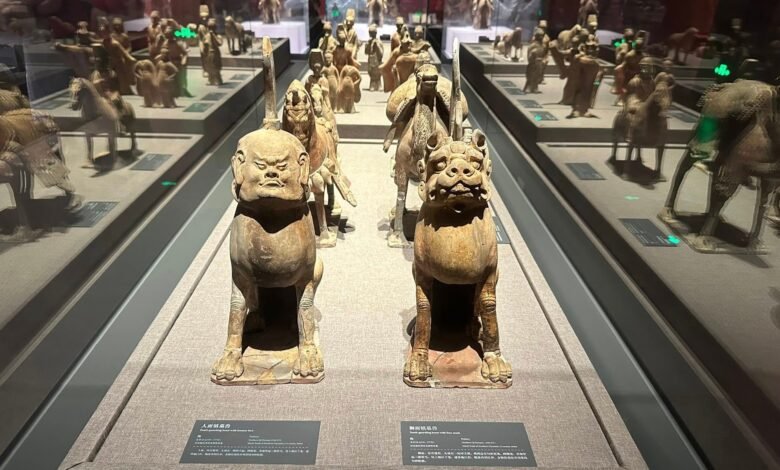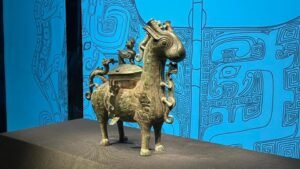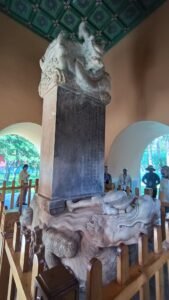العالم الآثاري المصري الدكتور محمد شبانة يكتب- سلسلة رحلتي إلي الصين: المتحف الصيني للآثار ومقابر أسرة مينغ (5)


أ- المتحف الصيني للآثار.
افتُتح المتحف الصيني للآثار، المعروف رسميًا باسم المتحف الأثري للصين، للجمهور في سبتمبر 2023 بالعاصمة بكين.
يضم المتحف ست قاعات عرض رئيسية، تُركّز كل منها على فترة تاريخية مختلفة، من العصور ما قبل التاريخ حتى أسرة تشينغ.
تبلغ مساحته الإجمالية أكثر من30 ألف متر مربع، ويتميز بتقنيات عرض حديثة وتجهيزات تفاعلية متعددة الوسائط.
من بين أبرز مقتنياته عظام العرافة، والأواني البرونزية من عصري شانغ وتشو، وبدلات الدفن المصنوعة من اليشم من عصر هان, كما يعرض أدوات حجرية، وخزفًا قديمًا، وأقمشة حريرية، وحُليًا ذهبية مستخرجة من مواقع أثرية بارزة في مختلف أنحاء الصين.
تضم قاعة التحف الخزفية مجموعة رائعة من الخزف الصيني عبر العصور، من الخزف الرمادي النيوليتي إلى الخزف الإمبراطوري المزجّج ومن بين المعروضات الشهيرة أوانٍ مزينة بالأزرق والأبيض وأخرى متعددة الألوان، تبرز تطور تقنيات الحرق والزخرفة, وتُظهر هذه التحف جمالًا فنيًا راقيًا إلى جانب أهميتها في الحياة اليومية والدينية في الصين القديمة.
من أبرز معالم المتحف أيضًا موقع دفن نيوليتي معاد ترميمه، يوضح طقوس الدفن القديمة في الصين.
يهدف المتحف إلى سرد تطور الحضارة الصينية من منظور أثري، بدلاً من الاكتفاء بالسرد التاريخي التقليدي القائم على السلالات, أما تصميمه المعماري، فيجمع بين البساطة الحديثة والعناصر الصينية التقليدية الهادئة، مما يخلق بيئة تأملية راقية, ويُعد المتحف مركزًا ثقافيًا مهمًا للبحث والتعليم والتعريف بالتراث الأثري الصيني الغني والمتنوع.
ب- مقابر أسرة مينغ:
تُعد مقابر أسرة مينغ من أبرز المعالم التاريخية والإمبراطورية في الصين، وقد بُنيت خلال فترة حكم سلالة مينغ (1368–1644) م, أُنشئت هذه المقابر لدفن أباطرة أسرة مينغ وأفراد عائلاتهم، بهدف تخليد ذكراهم وضمان احترامهم في الحياة الآخرة وفق المعتقدات الكونفوشيوسية.
تقع المقابر في منطقة جبلية شمال غرب بكين تُعرف باسم وادي الأباطرة، وتُحيط بها الطبيعة الخلابة مما يعزز الطابع الرمزي للموقع.
تضم المجمع 13 مقبرة ملكية، أبرزها مقبرة الإمبراطور يونغله، الذي نقل العاصمة إلى بكين وأمر ببدء المشروع.
صُمّمت المقابر بعناية وفق مبادئ الفنغ شوي لضمان التناغم بين الطبيعة والبناء، مما يعكس التوازن بين الأرض والسماء.
تشمل العناصر المعمارية بوابات حجرية ضخمة، ممر الأرواح، ساحات، أضرحة، وقاعات قرابين مزينة بالنقوش والتنانين الرمزية.
يُعد “طريق الأرواح” من أشهر أجزاء الموقع، وهو ممر طويل يكتنفه تماثيل حجرية لكائنات خرافية ومحاربين ترمز للحراسة والحماية.
تميّزت الزخارف بالروعة والدقة، حيث استخدمت الألوان الإمبراطورية مثل الأحمر والذهبي، إضافة إلى نقوش الزهور والتنين والعنقاء.
تُظهر هذه المقابر القوة والثراء الفني والروحي لعهد مينغ، وتعكس احترام الصينيين للأموات وعقيدتهم في الحياة بعد الموت (يُتبع).

My Journey to China Series: Chinese Archaeological Museum& The Ming Dynasty Tombs (5) by Dr. Mohamed Shabana, Egyptian Archaeologist.
A- Chinese Archaeological Museum.
The Chinese Archaeological Museum, officially known as the Archaeological Museum of China, opened to the public in September 2023 in Beijing.
The museum features six major exhibition halls, each focusing on a different historical period—from prehistoric times to the Qing dynasty.
It spans over 30,000 square meters and incorporates cutting-edge display technology and interactive multimedia installations.
Among its most notable artifacts are oracle bones, bronze vessels from the Shang and Zhou dynasties, and jade burial suits from the Han dynasty.
The museum also displays stone tools, ancient textiles, ceramics, and gold ornaments excavated from significant archaeological sites across China.
The ceramics hall features a stunning collection of Chinese pottery, from Neolithic grayware to brilliantly glazed imperial porcelains.
Famous exhibits include blue-and-white and multicolored vessels that showcase the evolution of firing techniques and decoration.
These ceramic pieces reveal both high artistic craftsmanship and their importance in the religious and daily life of ancient China.
One of the museum’s highlights is a reconstructed Neolithic burial site, offering insights into early Chinese funerary practices.
The museum seeks to tell the story of Chinese civilization through an archaeological lens, rather than a purely dynastic narrative.
Its architectural design blends modern minimalism with subtle traditional Chinese elements, creating a serene and reflective atmosphere.
It serves as a vital cultural hub for research, education, and appreciation of China’s rich and diverse archaeological heritage.
B- The Ming Dynasty Tombs.
The Ming Dynasty Tombs are among the most prominent historical and imperial landmarks in China, built during the reign of the Ming Dynasty (1368–1644 AD).
These tombs were constructed to bury Ming emperors and their family members, aiming to honor their memory and ensure reverence in the afterlife according to Confucian beliefs.
They are located in a mountainous area northwest of Beijing known as the “Valley of the Emperors,” surrounded by scenic nature that enhances the symbolic value of the site.
The complex includes 13 royal tombs, the most notable being the tomb of Emperor Yongle, who moved the capital to Beijing and initiated the project.
The tombs were carefully designed according to Feng Shui principles to ensure harmony between nature and architecture, reflecting the balance between earth and heaven.
Architectural features include grand stone gates, the Sacred Way, courtyards, shrines, and sacrificial halls decorated with symbolic carvings and dragons.
The famous “Spirit Way” is a long pathway lined with stone statues of mythical creatures and warriors symbolizing protection and guardianship.
The decorations are known for their richness and precision, featuring imperial colors like red and gold, along with motifs of flowers, dragons, and phoenixes.
These tombs reflect the artistic, spiritual, and political strength of the Ming era and express the deep Chinese respect for the dead and belief in theafterlife. …. To be Continued

